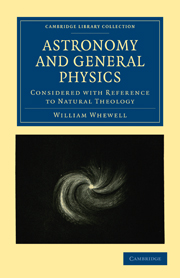Book contents
- Frontmatter
- NOTICE
- Contents
- INTRODUCTION
- BOOK I TERRESTRIAL ADAPTATIONS
- CHAP. I The Length of the Year
- CHAP. II The Length of the Day
- CHAP. III The Mass of the Earth
- CHAP. IV The Magnitude of the Ocean
- CHAP. V The Magnitude of the Atmosphere
- CHAP. VI The Constancy and Variety of Climates
- CHAP. VII The Variety of Organization corresponding to the Variety of climate
- CHAP. VIII The Constituents of Climate
- CHAP. IX The Laws of Heat with respect to Water
- CHAP. X The Laws of Heat with respect to Air
- CHAP. XI The Laws of Electricity
- CHAP. XII The Laws of Magnetism
- CHAP. XIII The Properties of Light with regard to Vegetation
- CHAP. XIV Sound
- CHAP. XV The Atmosphere
- CHAP. XVI Light
- CHAP. XVII The Ether
- CHAP. XVIII Recapitulation
- BOOK II COSMICAL ARRANGEMENTS
- BOOK III RELIGIOUS VIEWS
CHAP. X - The Laws of Heat with respect to Air
from BOOK I - TERRESTRIAL ADAPTATIONS
Published online by Cambridge University Press: 05 August 2011
- Frontmatter
- NOTICE
- Contents
- INTRODUCTION
- BOOK I TERRESTRIAL ADAPTATIONS
- CHAP. I The Length of the Year
- CHAP. II The Length of the Day
- CHAP. III The Mass of the Earth
- CHAP. IV The Magnitude of the Ocean
- CHAP. V The Magnitude of the Atmosphere
- CHAP. VI The Constancy and Variety of Climates
- CHAP. VII The Variety of Organization corresponding to the Variety of climate
- CHAP. VIII The Constituents of Climate
- CHAP. IX The Laws of Heat with respect to Water
- CHAP. X The Laws of Heat with respect to Air
- CHAP. XI The Laws of Electricity
- CHAP. XII The Laws of Magnetism
- CHAP. XIII The Properties of Light with regard to Vegetation
- CHAP. XIV Sound
- CHAP. XV The Atmosphere
- CHAP. XVI Light
- CHAP. XVII The Ether
- CHAP. XVIII Recapitulation
- BOOK II COSMICAL ARRANGEMENTS
- BOOK III RELIGIOUS VIEWS
Summary
We have seen in the preceding chapter how many and how important are the offices discharged by the aqueous part of the atmosphere. The aqueous part is, however, a very small part only: it may vary, perhaps, from less than 1-100dth to nearly as much as 1-20th in weight, of the whole aerial ocean. We have to offer some considerations with regard to the remainder of the mass.
1. In the first place we may observe that the aerial atmosphere is necessary as a vehicle for the aqueous vapour. Salutary as is the operation of this last element to the whole organized creation, it is a substance which would not have answered its purposes if it had been administered pure. It requires to be diluted and associated with dry air, to make it serviceable. A little consideration will show this.
We can suppose the earth with no atmosphere except the vapour which arises from its watery parts: and if we suppose also the equatorial parts of the globe to be hot, and the polar parts cold, we may easily see what would be the consequence. The waters at the equator, and near the equator, would produce steam of greater elasticity, rarity, and temperature, than that which occupies the regions further polewards; and such steam, as it came in contact with the colder vapour of a higher latitude, would be precipitated into the form of water.
- Type
- Chapter
- Information
- Publisher: Cambridge University PressPrint publication year: 2009First published in: 1833



